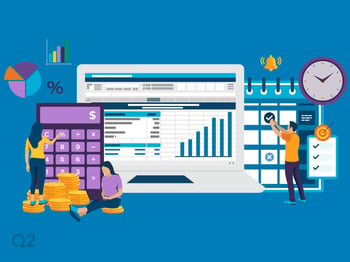Before the COVID-19 crisis, financial institutions (FIs) like yours were already working hard to meet ever-growing account holder expectations. The coronavirus pandemic has only increased the challenges of serving your customers and members, highlighting the critical importance of digital banking. Q2 recognizes these challenges, and we know that remaining the constant companion on your account holders' financial journey is essential for your success during this "new normal." Working closely with FIs like yours that serve small business owners, we consistently hear first-hand accounts of the challenges you are facing and working to address.
The battle for the small business customer
The digital channel has enabled fintechs and big tech firms to compete with FIs for primary financial relationships with small businesses. These new entrants to the market offer solutions that solve specific business problems with purpose-built digital banking functions. To compete with these fintechs, FIs need to better understand their customer’s business problems and provide more than traditional one-size-fits-all banking products, offering a suite of tailored financial products that are aligned with the needs of each business. They should seek to proactively target small business prospects and customers – here and now – with digital self-service solutions tailored to their needs. 85% of small business owners indicated they would prefer to buy fintech products from their FI1, but FIs must be able to identify and target small businesses within their markets by leveraging profile and behavioral data in order to offer relevant solutions. If FIs can offer adjacent financial solutions with easy access and integration with traditional banking services, small business owners will likely turn to them for purchasing these products, creating a better financial experience for the small business and a higher value relationship for the FI.
Market identification and promotion
What you don’t know can hurt you. Many FIs are not aware of their small business opportunities. These companies are often hiding among a bank or credit union’s consumer account holders or are forgotten among larger commercial and corporate customers. In many cases, the business owners and decision makers are so focused on their day-to-day tasks they aren’t aware of the help available to them from their financial institution, resulting in missed opportunities (and value) for everyone involved. Banks and credit unions will benefit from educating smaller businesses about the valuable products, solutions, and advice they offer.
At the same time, around 40% of these businesses feel that FIs don’t understand their needs or act as trusted partners.2 Many FIs fail to leverage the transaction and behavioral data they have collected to identify customer’s problems or opportunities to expand relationships with small businesses. To turn this perception, FIs must understand the small business customer segment, tailor products and experiences to their needs, and promote their solutions aggressively so businesses in their communities take notice.
One size doesn’t fit all
Changing expectations and market and user needs are forcing FIs to reevaluate strategies and product offerings. Businesses are managed and run by people; the valuable and usable technology experiences from their personal lives often influence their professional expectations. Yet FIs continue to adopt a one-size-fits-all approach to a diverse customer segment. Most FI’s either offer small businesses retail banking solutions that do not meet their financial needs or online cash management solutions that are overly complex and full of banking jargon that small businesses don’t understand. Unfortunately, FIs are choosing what is essentially the least bad option for their small business account holders, which ultimately results in a poor user experience. To win new and expand existing relationships with small businesses, they will need to provide the digital capabilities and experiences that are aligned with the personas of these businesses.
Scalable investment and charging for value
While factors such as competitive rates, access of branch locations, and personal interactions still influence small business’ selection decisions, companies are increasingly placing greater weight on an FI’s self-service digital capabilities.
Traditional go-to-market approaches of leveraging branch and direct sales staffs will not provide the reach FIs need to compete and win in the small business segment, forcing FIs to consider shifting to more effective, efficient, and scalable digital channels. There is no better illustration of this growing trend than the impact of COVID-19, which increasingly finds services for businesses being made available through the digital channel only. As small businesses become more comfortable with procuring and utilizing financial solutions through digital channels, their preference for digital solutions will likely continue into the future.
Time to value, speed, and convenience comprise the new loyalty
Speed is another technological aspect impacting the way banks and credit unions serve their prospective and current business customers. Gone are the days of rolling out new digital solutions over quarters or even years. Today’s customers and members expect the same immediate time-to-market delivery they experience from their consumer electronics. Small businesses demand the same convenience. They will turn to providers that can provide traditional banking, lending, and other financial products they need – when they need it – through easy-to-use, self-service digital solutions. This will require FIs to re-engineer their technology and internal processes in response to increasing expectations around speed – or risk losing small business loyalty to fintech and big tech providers.
Addressing these challenges is essential for FIs serving small businesses. Those that can respond to these challenges will become industry leaders, while those that cannot will struggle to remain competitive. The next entry in this series will uncover challenges FIs face in serving commercial and corporate customers.
Additional Resources
Learn more about Q2’s commercial banking solutions.
Read the Aite Matrix report, “The Leading Providers of U.S. Cash Management Technology, 2020,” to see our vision and progress in creating an end-to-end, modern commercial banking solution.
Check out our Treasury Onboarding eBook and learn about treasury onboarding challenges and how they can be solved.
View our recent “The Commercial Customer Journey” webinar where we explain the importance of the customer journey when undertaking digital transformation in commercial banking.
Sources
1. Aite Report: Meeting Small Business’ Needs Through a Consolidated Offering, October 2019
2. Aite Report: Understanding the True Needs of the Critical Small-Business Segment, September 2019




